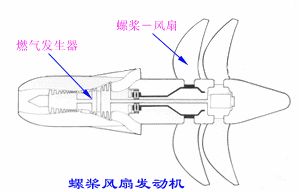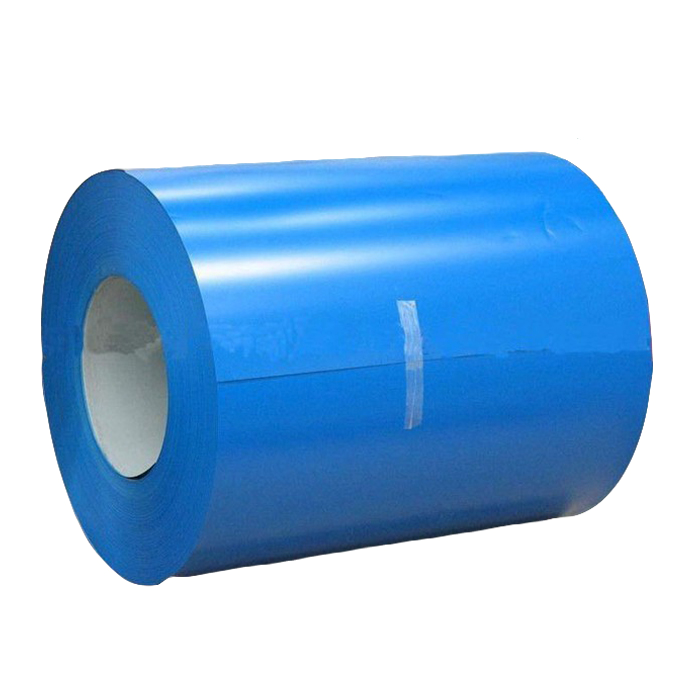The propeller fan engine is a form of engine between a turbofan engine and a turboprop engine. The goal is to combine the high speed performance of the former with the economics of the latter, and is currently in the research and experimental stage.

The structure of the propeller fan engine is shown in the figure. It consists of a gas generator and a propeller-fan (because it can't be given a name like a propeller and a fan, it has to be called a propeller-fan). The propeller-fan is driven by a turbine, has no ducted casing, and is equipped with a reducer. From this point of view, it is a bit like a propeller; but its diameter is smaller than that of a common propeller, and the number of blades is also large (generally 6 to 8 leaves). The blades are thin and wide, and the leading edge sweeps back, which are somewhat similar to fan blades.

According to the principle of the turbofan engine, the higher the bypass ratio, the higher the propulsion efficiency, so the new type of non-energized turbofan engine has a larger ducting ratio and is close to the structure. The turboprop engine with the ducted off, although the efficiency is high, cannot be applied to the modern high-sonic large-body wide-body aircraft of M0.8~M0.95 due to the speed limitation of the propeller, the propeller fan engine The concept came into being.
Due to the non-ducted outer casing, the ducted ratio of the propeller fan engine can be very large. Taking an engine under study as an example, when the flying speed is M0.8, the amount of air driven is about 100 times the intrinsic air flow. The equivalent of the bypass ratio is 100, which is beyond the reach of the turbofan engine. It can be applied to the aircraft, which can reduce the fuel consumption rate of the high altitude cruise by about 15% compared with the current high bypass.
Compared to turboprop engines, propeller fan engines are much more usable, depending on the shape of their blades. Ordinary propeller blades have large blade thicknesses to ensure strength, and the camber is large to ensure the lift coefficient. From the cross-sectional point of view, this type of blade is actually the wing profile shape of a typical low-speed aircraft, which is highly efficient at low speeds. However, once the speed of sound is approached, the efficiency drops sharply, so the speed of the aircraft equipped with the turboprop is limited to M0.6~M0.65; while the propeller-fan is both wide and thin, with a sharp leading edge and a swept back. The leaf shape is similar to the cross-sectional shape of the supersonic wing. The transonic performance of this type of blade is much better. It still has good propulsion efficiency when the flight speed is M0.8. It is the most promising of the new engines. One.

Of course, the propeller fan engine also has its shortcomings. Because of the high speed, the vibration and noise generated are also large, which is a problem for passenger aircraft with strict requirements for comfort. In addition, the aerodynamic design of the propeller-fan exposed to the air is also a difficult point of current research.
Steel coil is a kind of steel product which has been wound or coiled after rolling. The steel coil can be used on roof,wall and other purpose. There are several kinds of steel coil can be choosen for you: Galvanized steel coil, prepainted galvanized steel coil, galvalume steel coil, stainless steel coil.
The normal zinc coat is 40g/m2. Of course,we can produce the steel coil according to your requirement.The color is RAL colors.Our steel coil is 3-8 tons per roll.The grade is Q235,Q345.
Application: Structural use ,roofing, commercial use, household appliance, industry, family
Any requirement or questions,please feel free to contact with us at any time.And welcome to visit our factory.
Width
Thickness(mm)
Kg/M
M/T
1m
0.12
0.94
1061
0.13
1.02
979
0.14
1.1
909
0.15
1.18
849
0.16
1.26
796
0.17
1.31
749
0.18
1.41
707
0.19
1.49
670
0.20
1.57
636
0.21
1.65
606
0.22
1.72
579
0.23
1.81
553
0.24
1.88
530
0.25
1.96
509
0.26
2.04
489
0.27
2.12
471
0.28
2.2
454
0.29
2.27
439
0.30
2.36
424
0.31
2.43
410
0.32
2.51
398
0.33
2.59
386
0.34
2.67
374
0.35
2.75
363
0.36
2.82
353
0.37
2.9
344
0.38
2.98
335
0.39
3.06
326
0.40
3.14
318
0.41
3.22
310
0.42
3.3
303
0.43
3.38
296
0.44
3.45
289
0.45
3.53
283
0.46
0.47
0.48
0.49
0.5
3.93
254
0.55
4.32
231
0.6
4.62
212
Width
Thickness(mm)
Kg/M
M/T
1.2m
0.12
965
0.13
816
0.14
758
0.15
1.5
707
0.16
1.51
663
0.17
1.6
624
0.18
1.69
589
0.19
1.79
558
0.20
1.88
530
0.21
1.98
505
0.22
2.07
482
0.23
2.16
461
0.24
2.26
442
0.25
2.36
424
0.26
2.44
408
0.27
2.54
393
0.28
2.64
379
0.29
2.73
366
0.30
2.83
353
0.31
2.92
342
0.32
3.01
331
0.33
3.11
321
0.34
3.2
312
0.35
3.3
303
0.36
3.39
294
0.37
3.48
286
0.38
3.58
279
0.39
3.68
272
0.40
3.77
265
0.41
3.86
258
0.42
3.95
252
0.43
4.05
246
0.44
4.15
241
0.45
4.24
235
0.46
0.47
0.48
0.49
0.5
4.71
212
0.55
5.18
193
0.6
5.64
176

Steel Coil
Steel Coil,Steel Coil Prices,Steel Coil Weight,Steel Coil Racks
Shijiazhuang Zhouming Steel Building Materials Co., Ltd. , https://www.zmsteels.com